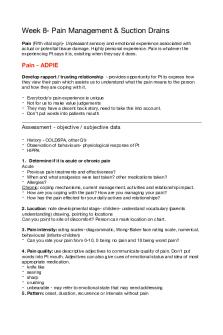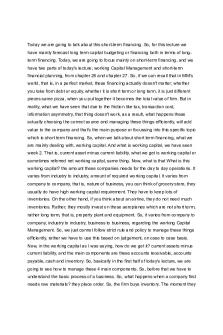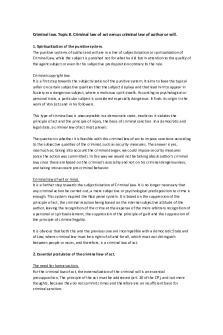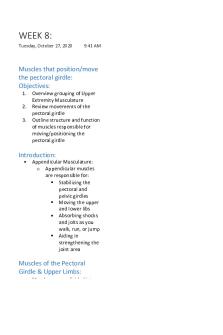Lecture 8 notes PDF

| Title | Lecture 8 notes |
|---|---|
| Course | Human Physiology |
| Institution | University of Pittsburgh |
| Pages | 4 |
| File Size | 97 KB |
| File Type | |
| Total Downloads | 14 |
| Total Views | 124 |
Summary
Block 2, Lecture 8 notes, Dr. Sved...
Description
Human Physiology NROSCI/BIOSCI 1250 Lecture 8, Striated Muscle Muscle: Cells that are specialized for contraction. Nearly half of the body mass is muscle. (slide 1) There are 3 types of muscle cells: based on anatomical appearance, but also functional characteristics: skeletal muscle (the most prevalent, ~ 80%)), cardiac muscle, and smooth muscle. Both skeletal muscle and cardiac muscle have a striated (banded) appearance under the microscope, but typically the term striated muscle is used to refer to skeletal muscle. Smooth muscle lacks the striated appearance. [slide 2] Skeletal muscle is also referred to voluntary muscle; it contracts only in response to nerve impulses from somatic motor neurons. [Why is that considered voluntary?] Smooth muscle and cardiac muscle are not under conscious voluntary control and are typically called involuntary or autonomic muscle. They are under the control of the autonomic nervous system, and some also respond to endocrine and paracrine signals. [Remember that we discussed autonomic and endocrine integration at both CNS and peripheral levels (ganglia, target tissues).] In addition, some involuntary muscles can contract in the absence of any signal from outside the muscle (i.e., they are capable of spontaneous contraction; we will discuss some such cells in the gastrointestinal tract).
Skeletal muscle Skeletal muscle is made up of muscle fibers, which are a syncitium (i.e., multinucleated unit) formed from the fusion of individual myoblasts. Each of these multinucleated units is bounded by a membrane, the sarcolemma (i.e., the “cell” membrane of skeletal muscle); the sacrolemma surrounds sarcoplasm (i.e., the cytoplasm of skeletal muscle). The endoplasmic reticulum in muscle is specialized and extensive; it is called sarcoplasmic reticulum. (slide 3) Throughout these large multinucleated “cells” the sarcolemma forms channels [note: this term is being used differently than membrane proteins that make channels through membranes] that run into and through the cells – T-tubules. (slide 4) A muscle is made up of a bunch of muscle fibers held in a bundle by connective tissue. A large muscle may contain several thousand muscle fibers.
1
Each muscle fiber is made up of thousands of myofibrils, which are bundles of contractile proteins and elastic proteins = (slides 4). What are these proteins: Contractile proteins: actin and myosin Myosin = thick filament; ~15 nm; ~1500/myofibril Actin = thin filament; ~ 5 nm; ~3000/myofibril Proteins regulating contractions: troponin and tropomyosin Accessory proteins: titin, nebulin (we won’t talk much about these, though I will comment on the role of titin in muscle relaxation) cross bridges - part of myosin molecule that extends from the surface toward the thin filament Go through the structure of a muscle fiber. Understand what constitutes the banding pattern. (slide 5). Z-line (also called Z disk, which is more appropriate for 3 dimensions), I band, A band, H zone, M line; know these terms. A sarcomere is the portion of a myofibril bounded by Z lines. The sarcomere is the smallest contractile unit of striated muscle. The resting length of a sarcomere is ~2 micrometers. [go through structure of thick and thin filaments – (slide 6)] structure of actin: strings of balls (polymer of globular protein) myosin: each molecule is shaped like a golf club note organization in 3 dimensions (slide 7)
Contraction The sliding filament theory; the cross bridge cycling model: sliding of the thick and thin filaments along each other, caused by the shifting of the cross bridge portions of the myosin heads; sarcomeres shorten but thick and thin fibers do not. (slide 8) [as an aside, note the role of other proteins, such as titin (slide 9)] Contraction is produced by the cross bridge cycle: (slide 10) -attachment of cross bridge to thin filament -movement of the bridge -detach bridge from thin filament -reset cross bridge to original position (one cross bridge cycle shortens a sarcomere by ~ 5-10 nm and takes about 200 microsec; if each thick filament has ~200-300 myosin molecules, then the thick filament can move relative to the thin by ~15 micrometers/sec)
2
ATP has two functions in the cross bridge cycle: 1. energy to move the bridge, 2. binding of ATP dissociates actin and myosin
How is contraction regulated? (Why isn’t muscle always in the state of contraction?) (slide 11) There is an essential role of Ca++ - tropomyosin prevents cross bridge interaction with actin (slide 12) - tropomyosin is held in place by troponin - Ca++ binding to troponin causes tropomysosin in effect to move out of the way (slide 13) Øso cytosolic Ca++ determines the amount of cross bridge binding; normally very low (0.1 microM) Excitation -contraction coupling: (i.e., what causes Ca++ levels inside the muscle increase?) (slide 14) -muscles are excitable cells capable of generating action potentials (i.e., they have voltage gated Na channels) -the action potential causes release of Ca++ from sarcoplasmic reticulum into the sarcoplasm. A voltage sensitive membrane protein, the dihydropyridine (DHP) receptor, that is coupled to the Ca++ channel in the sarcoplasmic reticulum through another protein, the ryanodine receptor. (Slide 14) (Note, the DHP and ryanodine receptors are not receptors in the way we have been using this term; rather they are proteins that were identified and named by actions of exogenous chemicals.) Slide 15 again shows the relationship between the T tubules and the sacroplasmic reticulum. -Ca++ is then put back into the SR by Ca++-ATPase (i.e., a Ca++ pump). Note, this is a third role of ATP in contraction. (slide 16). It is important to remember that this process takes a while (~100 msec). So, what activates the DHP receptor? (slide 17) - The muscle action potential (slides 18,19) Whereas the muscle action potential lasts ~2 msec and this initiates the increase in cytosolic Ca++, the increase in cytosolic Ca++ and therefore contraction lasts ~ 100 msec.
3
How is the muscle AP initiated? Neural input (slide 20)
neuromuscular transmission: Motor neurons release acetylcholine at the neuromuscular junction. The neuromuscular junction is a specialized point of communication between motor neuron and muscle (slide 21). The motor neuron terminals are set up to release a lot of acetylcholine and the structure of the neuromuscular junction is set up to insure contraction.
Slide 22 reviews the sequence of events leading to contraction of skeletal muscle. (At what steps might drugs interfere with this process and result in paralysis? )
Motor Units: a motor neuron innervates several to many muscle fibers = motor unit (i.e., a motor unit is the motor neuron and the muscle fibers it innervates. Remember that for skeletal muscle a muscle fiber receives input from only a single motor neuron.) (slide 23)
4...
Similar Free PDFs

8 - Lecture notes 8
- 21 Pages

8 - Lecture notes 8
- 21 Pages

8 Midwifery - Lecture notes 8
- 3 Pages

Taxation 8 - Lecture notes 8
- 2 Pages

Week 8 - Lecture notes 8
- 6 Pages

Dox 8 - Lecture notes 8
- 21 Pages

Lesson 8 - Lecture notes 8
- 2 Pages

Assignment 8 - Lecture notes 8
- 4 Pages

Week 8 - Lecture notes 8
- 23 Pages

WEEK 8 - Lecture notes 8
- 10 Pages

CL-8 - Lecture notes 8
- 12 Pages

Tema 8 - Lecture notes 8
- 8 Pages

Lesson 8 - Lecture notes 8
- 19 Pages

Chapter 8 - Lecture notes 8
- 7 Pages

Chapter 8 - Lecture notes 8
- 2 Pages

Chapter 8 - Lecture notes 8
- 7 Pages
Popular Institutions
- Tinajero National High School - Annex
- Politeknik Caltex Riau
- Yokohama City University
- SGT University
- University of Al-Qadisiyah
- Divine Word College of Vigan
- Techniek College Rotterdam
- Universidade de Santiago
- Universiti Teknologi MARA Cawangan Johor Kampus Pasir Gudang
- Poltekkes Kemenkes Yogyakarta
- Baguio City National High School
- Colegio san marcos
- preparatoria uno
- Centro de Bachillerato Tecnológico Industrial y de Servicios No. 107
- Dalian Maritime University
- Quang Trung Secondary School
- Colegio Tecnológico en Informática
- Corporación Regional de Educación Superior
- Grupo CEDVA
- Dar Al Uloom University
- Centro de Estudios Preuniversitarios de la Universidad Nacional de Ingeniería
- 上智大学
- Aakash International School, Nuna Majara
- San Felipe Neri Catholic School
- Kang Chiao International School - New Taipei City
- Misamis Occidental National High School
- Institución Educativa Escuela Normal Juan Ladrilleros
- Kolehiyo ng Pantukan
- Batanes State College
- Instituto Continental
- Sekolah Menengah Kejuruan Kesehatan Kaltara (Tarakan)
- Colegio de La Inmaculada Concepcion - Cebu